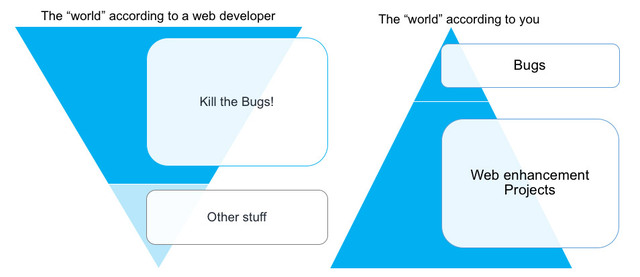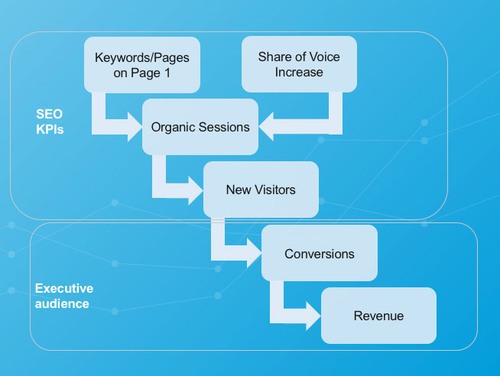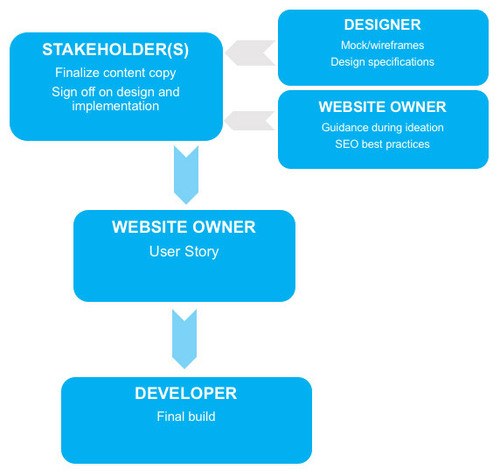Among all digital marketing goals the most important one is simple: to help grow business. Accomplishing that is where it gets complicated. Here's an introduction on how to get the internal buy-in and resources that you will need.
Content is the fuel that powers meaningful growth, capturing every relevant moment in search with an engaging and convincing story. If content is fuel, then your website is the engine that needs to be maintained and optimized continually. There’s no sense in pouring in more fuel, expecting phenomenal results, if the engine is leaking oil. We know that every organization is different, and every website is different. It follows that every web team is different too. That said, there are a couple of common traits we see in the community:
- A backlog of projects that could keep you busy for weeks, if not longer
- Limited resources to take actions on the items on your backlog
- Having to collaborate with other specialists, like designers and web developers to accomplish many of your longer-term goals
Therefore, more often than not, many website enhancements can’t be done by a website owner working alone. Significant enhancement projects, like new interactive site features, new page templates, or overhauling information infrastructure, typically require help from web developers. This is an issue near and dear to our hearts. Therefore, BrightEdge put together some of our best practices on how to get the buy-in and resources you need to accomplish your website enhancement projects.
Types of website projects
Not all website projects are created equally. Most of the time you can categorize web projects into two broad categories:
- Bugs
- Enhancements
Bugs
Bugs are generally any kind of broken or inoperable feature, element, or experience on your site. A drop-down menu that doesn’t render properly in Chrome on mobile devices is an example. Hyperlinks that 404 and buttons that don’t work are also good examples. The turnaround time on bugs is typically (and ideally) short, and the priority for getting them resolved is very high for both the business as well as engineering sides of the aisle. Just about anyone can report a bug, including end users of your site and not just people within your organization.
Enhancements
In contrast to bugs, site enhancements are projects that drive growth for the website and provide new experiences and functions for visitors. These can be things, like new page templates, full site redesigns, and more. Generally though, the level of complexity is much higher than it would be for a simple bug fix and requires a greater amount of resource investment. Because the complexity level varies so much, the delivery time can differ considerably from project to project. Since the necessity of site enhancement projects isn’t always as self-evident as it is for bug fixes, it’s often the web owner’s responsibility to communicate business value to stakeholders and any other involved parties.
Discovering web project opportunities
It’s hard to get buy-in on your projects if you don’t have a prioritized backlog of proposed projects you can point to and articulate the business value of each. Modules like ContentIQ can help you to evaluate your website as it exists today and identify areas of improvement or potential growth. It gets overwhelming very quickly when grooming the website to identify site errors. A sensible way to prioritize these site errors is as follows.
- First, fix site-wide performance issues
- Then identify key pages, measured by revenue, conversion or website traffic contribution, to fix or enhance first
- Fix severe errors on key pages
Secure commitment
Once you’ve built your backlog of web projects, the next step is to secure resources commitment from your web development team. While many web owners have some degree of technical proficiency in HTML, JavaScript, etc., the reality is that few have the skill level or free time necessary to simply build out, say, a new web page template on their own, much less lay out the wireframes and mocks on their own. We need to collaborate to achieve our digital marketing goals. Sometimes this is easier said than done. Web developers don’t just exist to execute on the enhancement projects that are brought forward by a marketing manager. They have their own set of responsibilities that have to be balanced against, most of which focus around minimizing turnaround time on bugs and working together with a DevOps team to maintain site integrity and uptime. Here is a quick illustration of the “mismatched worlds” of the web developer and you, the web marketing lead. 
User stories
A big asset in securing commitment is the user story. The term “user story” is used in Agile development models, but is just a term for the master sheet that catalogs all the information a web developer needs to estimate the scope of a project and proceed with development. Ideally, a user story should also be a reliable reference guide for a QA team when testing proper functionality and for any prospective audience within the organization to read and have an understanding of the ask and its business rationale. Web owners should develop their skill in creating this kind of documentation for their web enhancement projects. The format and layout of these documents can vary based on the organization and team structure, but typically include the following elements:
- Detailed breakdown of features and intended functions of each
- Business rationale for the project
- Criteria for what elements need to be in place for the project to be considered in a “completed” state
- Digital marketing goals: The metrics you’ll be measuring
- All related content and design materials
Implement
A web owner’s job doesn’t end once a project gets greenlit. Complications can and will arise, and an effective web owner will take the initiative to clear blockers and make sure that their team is equipped with everything it needs to succeed. A common source of blockers is not having all of the necessary materials on hand before development begins. Depending on the project requirements, it’s a good practice to make sure that everything is in order and aggregated in the user story before making the handoff to the web developer(s) to begin their work. Below is an example flowchart depicting the kinds of materials everyone involved in an enhancement project would be responsible for. While the web owner’s responsibility is to make sure that all of those materials flow down to them to incorporate into the user story before developer handoff, this chart highlights the importance to “teaching to fish” - inform your content owners about the full workflows and the importance for them to drive their own project assets to completion before throwing the project over the fence to you. One of the common misunderstanding is unfinished copy deck for the new web page. The reality is: if the copy deck is not completed, the design of the new web page might not look right after it is coded.
Measure
Any web owner knows that an enhancement project doesn’t end with a “Mission Accomplished!” when the work is deployed on the website. Marketers measure success through impact, and a major part of the documentation any web enhancement project is detailing the KPIs you will evaluate. Having this in place from the get-go makes it much easier to track progress towards your digital marketing goals. Monitor impact closely and run analyses comparing post-deployment KPIs to pre-deployment numbers (normalizing the time measures being compared). Additionally, deploy tracking features like page visitor heatmaps, clickpath mapping, and conversion goals to evaluate whether your new features are driving the kinds of user behavior you want. 
Provide feedback, share wins
This is one of the easiest steps to overlook, but also one of the most important to ensure ongoing successes in your job. Obviously, it’s important to communicate when accomplishment of digital marketing goals vertically to stakeholders, superiors, and subordinates, but it’s just as beneficial to share successes -- such as any of the metrics in the infographic above -- to keep developers in the loop on the business impact of their work and build morale. All of this helps to encourage enthusiasm and future collaboration down the line. You should also take the initiative to share your feedback and get feedback from other team members. Conducting retrospective meetings to compare notes on what went well and what could be improved next time around is an essential part of the Scrum development framework and can be beneficial in virtually any kind of team structure. For an in-depth walkthrough of this 5-step process, be sure to view Launching Site Enhancements That Yield High ROI, part of our Elevating SEO webinar series.


